The Need for a Diverticulitis Diet
Diverticulitis is a painful and upsetting disturbance in the digestive tract, a colon disease, which can be effectively treated with the diverticulitis diet. While some individuals experience constant discomfort, others experience diverticulitis that wanes, and then flares up.
Diet, and a variety of risk factors can increase your chances of suffering from diverticulitis, especially after the age of 40.
What is Diverticulitis?
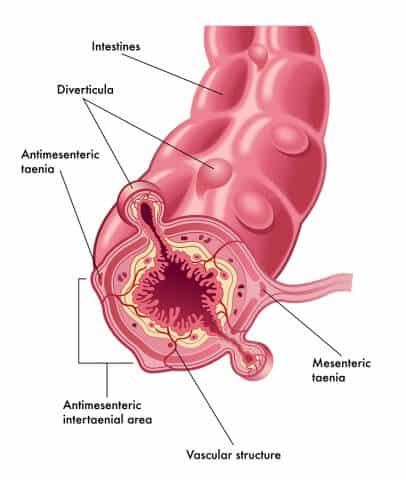 Diverticulitis is the infection of the small sacs of diverticula that line the digestive tract. Diverticula seldom cause problems, or severe discomfort, unless they become inflamed or infected, in which case, the diagnosis is diverticulitis.(1)
Diverticulitis is the infection of the small sacs of diverticula that line the digestive tract. Diverticula seldom cause problems, or severe discomfort, unless they become inflamed or infected, in which case, the diagnosis is diverticulitis.(1)
It is believed that 10% of Americans, over the age of 40, is affected by diverticular disease. The rate continues to increase through aging. In cases of a serious infection, antibiotics may be needed, in addition to a change in diet.
Many people find relief by limiting flare-up foods, and focusing on foods that are easily digested. Think of diverticula as storage sacs of plaque, much like what can clog arteries, except they reside typically in the lower part of the large intestine.
As with clogged arteries, it is important to first clear the area, and then continue with a healthy diet.
Diverticula sacs can become blocked with fecal matter, allowing bacteria to build, resulting in an infection. As the sacs grow, they put an increasing amount of pressure on the walls of the intestine, leading to pain, gas, abdominal discomfort, and other diverticulitis symptoms.
This pressure is increased during bowel movements; be mindful that constipation is both a symptom, and a contributing factor to worsening symptoms.
Left untreated, infection and perforation may lead to scarring in the digestive tract where scar tissue may cause a partial or complete blockage. This is why it is essential to make the necessary changes to help heal your digestive tract.
Diverticulitis Symptoms
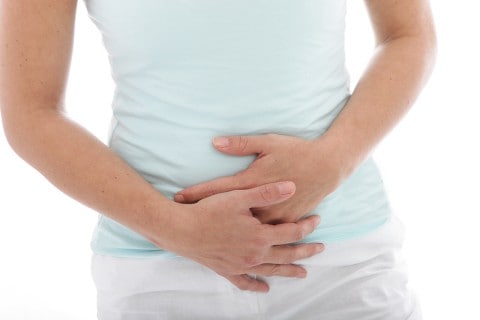 In the early stages, mild diverticulitis symptoms can be treated with rest and the diverticulitis diet. Severe or recurring diverticulitis may eventually require surgery for relief.
In the early stages, mild diverticulitis symptoms can be treated with rest and the diverticulitis diet. Severe or recurring diverticulitis may eventually require surgery for relief.
That is why it is essential to watch for warning signs, and start making dietary and lifestyle changes as soon as possible.
If you are experiencing two or more of the following symptoms, you may have diverticulitis.
- Marked change in bowel habits
- Severe abdominal pain
- Cramping
- Tenderness in the lower abdomen
- Nausea
- Alternating diarrhea and constipation
- Fever and/or chills
Causes of Diverticulitis
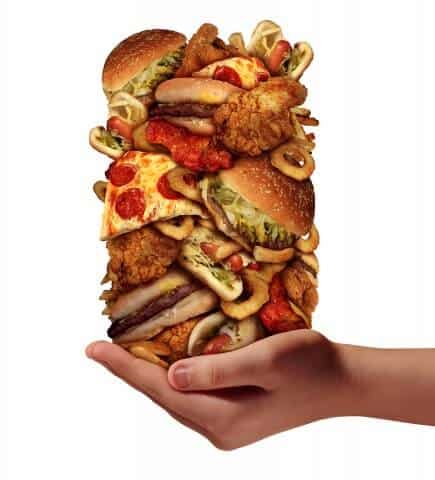 Today’s typical western diet often consists of highly processed foods, sugar, and unhealthy fats. This type of diet contributes to the development of diverticula, and an infection.
Today’s typical western diet often consists of highly processed foods, sugar, and unhealthy fats. This type of diet contributes to the development of diverticula, and an infection.
Eating a diet rich with fiber can help to prevent diverticulitis, and helps in the healing of the colon. (2) In addition to a poor diet, there are other risk factors to consider:
- Aging
- Obesity
- Smoking
- Prescription medications including opiates, steroids, and non-steroidal anti-inflammatories
- Lack of regular aerobic exercise
All of these risk factors, combined with a diet lacking in necessary fiber, and high in animal fats, can lead to the development of marble-sized diverticula in the digestive tract.
The resulting inflammation, infection, and leakage into the abdominal cavity is uncomfortable at best, and has the potential to cause serious complications.(3)
3 Natural Steps To Heal Diverticulitis:
STEP 1: The Healing Diverticulitis Diet
STAGE 1
During a diverticulitis flare-up, or at first symptoms, it is important to help your digestive tract clean itself out, and begin to heal. Start by using mybeef bone broth recipe.
Eating bone broths made from beef, chicken, lamb and fish helps to heal leaky gut syndrome, improves joint health, boosts the immune system, and even helps to reduce cellulite, all while helping to heal the digestive tract.
Bone broths with cooked vegetables and a little bit of meat, provides essential nutrients you body needs, including calcium, magnesium, phosphorus, silicon, sulphur, and more, in an easily digested manner.
You may add vegetables to your bone broth including carrots, celery and garlic or for variation, you may add an egg poachedin the broth. In addition, sip on warm ginger tea two to three times daily to help reduce inflammation and aid in digestion.Ginger is a healing food that helps your immune and digestive systems.
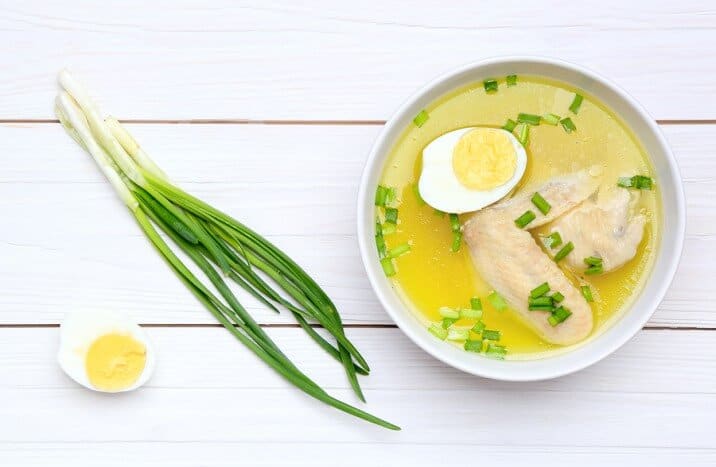 For beef, the collagen in the bones breaks down into gelatin within about 48 hours, and for chicken it is about 24. You can make broth in less time, but to get the most out of the bones, I recommend making it in a crock pot closer to 48 hours.
For beef, the collagen in the bones breaks down into gelatin within about 48 hours, and for chicken it is about 24. You can make broth in less time, but to get the most out of the bones, I recommend making it in a crock pot closer to 48 hours.
Gelatin has amazing curative properties and even helps individuals with food sensitivities and allergies tolerate these foods more easily. It also promotes probiotic balance, while breaking down proteins making them easier to digest. The truth about probiotics and digestive problems is that they help to create a healthy environment in your belly.
During this first phase of the diverticulitis diet, consume only clear bone broths, clear fresh juices (no pulp), and soothing ginger tea.
STAGE 2
Once the diverticulitis symptoms have eased, you can move on to stage two of the diverticulitis diet and introduce easily digestible foods including grated, steamed and then pureed fruits and vegetables, while still drinking ginger tea and bone broth soups.
Juicing fresh organic fruits and vegetables can provide a boost of nutrients. Carrots, beets, grapes, apples, lettuce and watercress can be juiced and enjoyed during this stage. Avoid foods with tough skins and small seeds as they can accumulate in diverticula sacs.
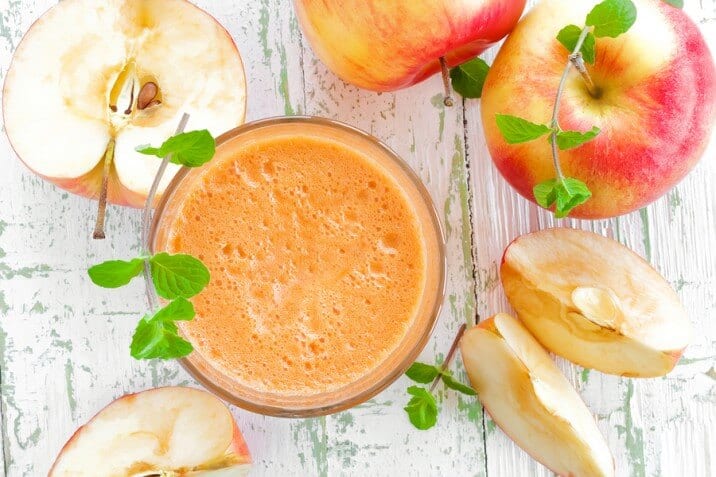
STAGE 3
When your body has adapted to the foods in Stage 2, start to add fiber rich foods including raw fruits and vegetables, and unrefined grains, such as quinoa, black rice, fermented grains, or sprouted lentils. It is important to stay away from whole nuts and seeds, as they can easily become trapped in the diverticula, causing further damage.
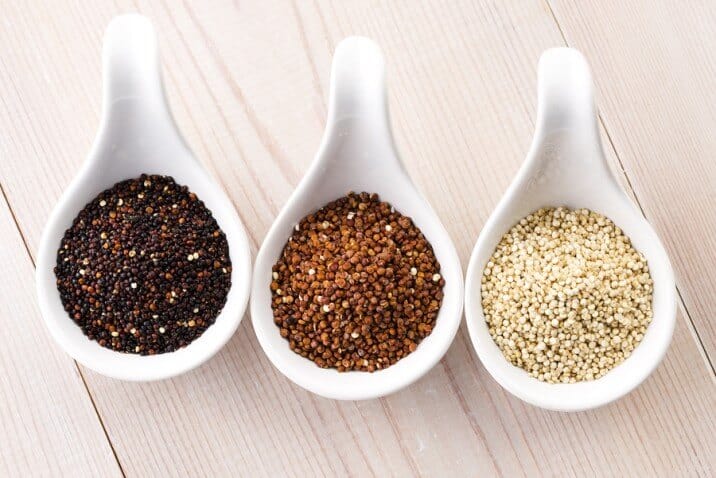
While seeds, nuts and popcorn are not the cause of diverticulitis, during this stage in healing, it is best to avoid them. (4) Once your diverticulitis symptoms have ebbed, you can return to enjoying these foods, and others, in moderation.
Listen to your body; if at any point you start to experience diverticulitis symptoms again, return to the previous stage. It may take as long as a few months to completely heal your digestive tract.
STAGE 4
According to researchers at the University of Oxford, fiber reduces the risk of diverticular disease.(5) The study focused on fiber from fruits, vegetables, cereals, and potatoes.
So over the first few days of stage four, introduce high-fiber foods gradually, adding just one new food every 3-4 days.
As your body starts to adapt you can begin consuming about 25-35 grams of fiber each day, to help stave off any potential flare-ups, while your digestive tract heals. Add in some potatoes, sweet potatoes, root vegetables, then slowly try some non-processed grains/beans such as oats or lentils.
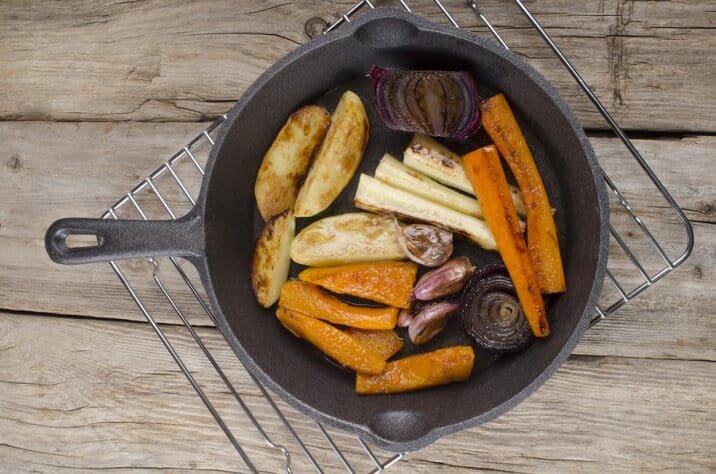
One important distinction is the difference between soluble fiber, and insoluble fiber. Soluble fiber actually retains water, and turns into a gel during the digestive process. The gel helps to slow the digestion, allowing for greater absorption of essential nutrients. (6) Insoluble fiber, on the other hand, adds bulk to stools, allowing foods to more quickly leave your system.
Foods high in soluble fiber include oat bran, nuts, seeds, beans, lentils barley, and peas. Insoluble fiber is found in foods including whole grains, wheat bran, and vegetables.
Researchers at the Department of Nutrition at Harvard Medical School found that it is the insoluble fiber that decreases risk for developing diverticular disease. (7) But do not let this sway you from eating a balanced diet. You do not have to eliminate soluble fiber, nor should you.
Maintaining a healthy balance of protein, fiber, and fresh fruits and vegetables, is essential for keeping diverticulitis from flaring up.
STEP 2. Supplements To Cure Diverticulitis
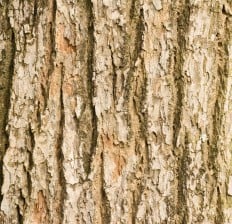 SLIPPERY ELM
SLIPPERY ELM
Native Americans have used slippery elm for centuries both externally, and internally to soothe digestive problems and relieve coughs and sore throats. (8)
Today, it is recommended to relieve the symptoms of GERD, Crohn’s disease, IBS, and digestive upset. Start by taking 500 milligrams, 3 times daily, throughout the course of the diverticulitis diet. Be sure to take with a full glass of water, or other clear liquid.
ALOE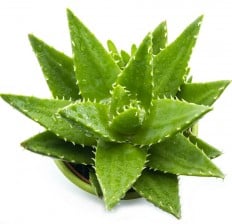
Aloe, in a juice form, aids in digestion, helps to normalize pH levels, regularizes bowel processing, and encourages healthy digestive bacteria. It is important to avoid aloe vera juice with “aloe latex”, as it can cause severe stomach cramping and diarrhea.
12 to 16 ounces per day of aloe juice is recommended; any more than that can further irritate your system.
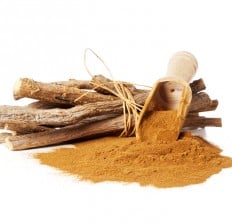 LICORICE ROOT
LICORICE ROOT
Licorice Root lowers stomach acid levels, can relieve heartburn, and acts as a mild laxative to help clear your colon of waste. This root helps to increase bile, aiding in digestion, while lowering cholesterol levels. Take 100 milligrams daily when experiencing diverticulitis symptoms.
 DIGESTIVE ENZMES
DIGESTIVE ENZMES
In addition to healing your colon from diverticulitis, the overall goal of the diverticulitis diet, supplements, and lifestyle changes, is to encourage your digestive tract to function optimally.
Digestive enzymes help break down foods, making it possible to absorb nutrients. Individuals with digestion problems can take digestive supplements that contain essential enzymes to facilitate digestion.
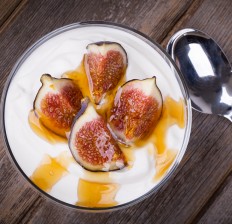 PROBIOTICS
PROBIOTICS
Live probiotics should be added to the diet to help negate food sensitivities, and relieve digestive upset including constipation, gas, and bloating.Probiotics are healthy bacteria that traditionally line your digestive tract to combat infection. If you have diverticulitis you need an influx of these bacteria to aid in the healing of your colon, while preventing disease recurrence.(9)
STEP 3. Lifestyle Changes Necessary To Cure Diverticulitis
Diverticulitis requires more than just a healing diverticulitis diet, and supplements to aid in a healthy digestive tract. Digestion starts in the mouth. It is essential to thoroughly chew each bite of food, until it is nearly liquefied. The more you break down the food before it hits the stomach, the more ready nutrients are ready to be absorbed.
Medical studies show that the combination of physical activity and high fiber diets helps to prevent diverticular disease.(10) Running, or using a rebounder daily, helps to relieve symptoms and reduce flare-ups. Even moderate intensity exercise helps to regulate bowel functions, reduces stress, and supports healthy weight.
Your psychological health is an integral part of your wellness; managing stress and learning effective coping mechanisms is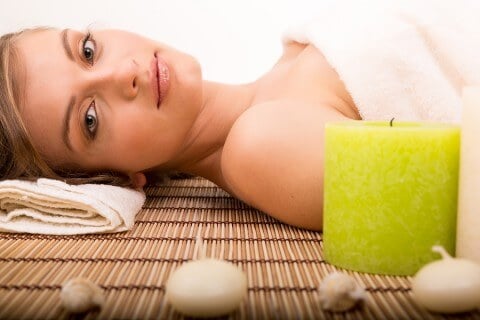 essential. Stress affects not only the mind, but the body as well. In my video 16 ways to bust stress, you can learn how to effectively manage daily stress.
essential. Stress affects not only the mind, but the body as well. In my video 16 ways to bust stress, you can learn how to effectively manage daily stress.
Straining while on the toilet creates too much pressure in the colon resulting in small tears. Choose to elevate feet slightly on a stool as this helps to reduce straining.
Diverticulitis Side Effects
Through integrative natural therapies that include a healing diet, natural supplements, and lifestyle changes, you can heal your digestive tract, and move forward without pain and discomfort.
While there are rarely any complications when taking nutritional supplements or food, I always recommend seeing a health professional immediately should you experience:
- Sustained fever and/or chills
- Continued nausea and vomiting
- Blood in stool
- Severe pain in a localized area of the abdomen
- Rectal bleeding
- Signs of shock including feeling dizzy or weak
These symptoms may be indicative of diverticular bleeding, a fistula (or an abnormal connection) between the bowel and urinary tract, or other serious complications.(11) Fecal matter and waste may leak out of the intestines, into the abdominal cavity, or urinary tract. Abscesses and obstructions are possible.(12)
For the vast majority of diverticulitis, natural healing methods, such as a diverticulitis diet, will be effective in overcoming this disease.
What to Expect While Healing
 In most cases, individuals who follow the three steps for healing outlined above, will start to see relief in a few days. As your symptoms begin to lessen, continue with the diverticulitis diet and lifestyle changes to ensure you give yourself time to heal.
In most cases, individuals who follow the three steps for healing outlined above, will start to see relief in a few days. As your symptoms begin to lessen, continue with the diverticulitis diet and lifestyle changes to ensure you give yourself time to heal.
Diverticulitis is not healed overnight; it is a process that can take a couple of months. Be patient, and don’t lose faith.
Soon, you will start to enjoy your life again. Throughout the process be sure to get plenty of rest, and manage stress. You may find yourself losing stubborn weight, and over time, energy levels will increase.
It is important to remember that maintaining a healthy diet, rich with foods in high fiber, low in unhealthy animal fats, and probiotic supplements can help keep diverticulitis flare-ups away.
For more about healing your gut and other natural cures, check out some of my other articles, such as the GAPS Diet Plan and Protocol and the Truth About Probiotics and Digestive Problems.